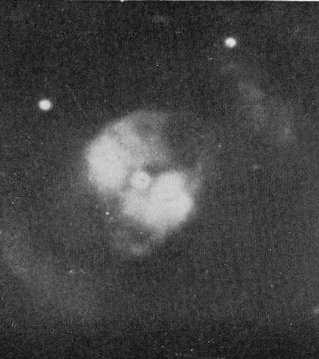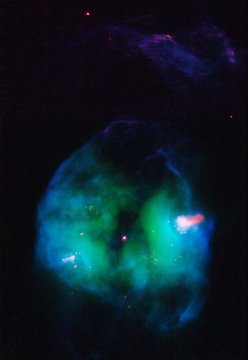NGC 2371-2
Curtis writes "...two lobes which together form an irregular and
patchy oval...A vacant lane runs between the lobes...and widens to
include the central star." The lobes' prominence make NGC 2371-2
(in northern Gemini
between Iota Gem and
Castor) unusual in that it is one of four
planetary nebulae to carry not one, but two, entries in the New
General Catalogue. The western, right-hand lobe, down and to the
right of the star in Curtis's century-old photograph, is NGC 2371,
the other (to the upper left) is NGC 2372, the early explorers not
knowing that they were two parts of the same object. The others
are NGC 650-1 (Messier 76), NGC 2474-5 (mis-named from another NGC
object), and NGC 6164-6, to which we might add IC 5148-50.
Surrounding the inner lobes is a huge halo that seems illuminated
by the ultraviolet light that sneaks out through the lane. On the
right is the highly detailed Hubble view (rotate it about 40
degrees to the right to match Curtis's photo). Here, the upper
right part of the halo is faintly visible, Curtis showing it
better. The Hubble image, however, reveals opposing jets that are
best seen as NGC 7009's ansae and that
probably fly along the star's rotation axis. (They are well-seen
in NGC 3242 and NGC
6543 as well.) Note their tilt, the upper right one seeming
more to come somewhat toward the observer. The surrounding nebular
gas is disturbed as the jet breaks through.
Even at a (highly uncertain) distance of 5000 light years, NGC
2371-2 is angularly one of the larger nebulae, the full extent of the outer
halo two minutes of arc wide. The inner lobes stretch out 1.3
light years, the outer halo a full three light years, three-fourths
the distance between the Sun and Alpha Centauri.
The whole structure is illuminated by a hot 15th magnitude (14.8)
central star of 118,000 Kelvin, the star shining with the light of
perhaps 700-1400 Suns. The star seems to be near its maximum
temperature (though it is hard to tell given the poor distance),
and should shortly start to dim toward the realm of the white dwarfs, as the nebula
-- expanding at the good clip of 43 kilometers per second -- slowly
dissipates into the mists of interstellar space.
Left: Image and quote by H. D. Curtis from Publications of the Lick
Observatory, Volume 13, Part III, 1918. Right: NASA, ESA, and the
Hubble Heritage Team (STScI/AURA).



